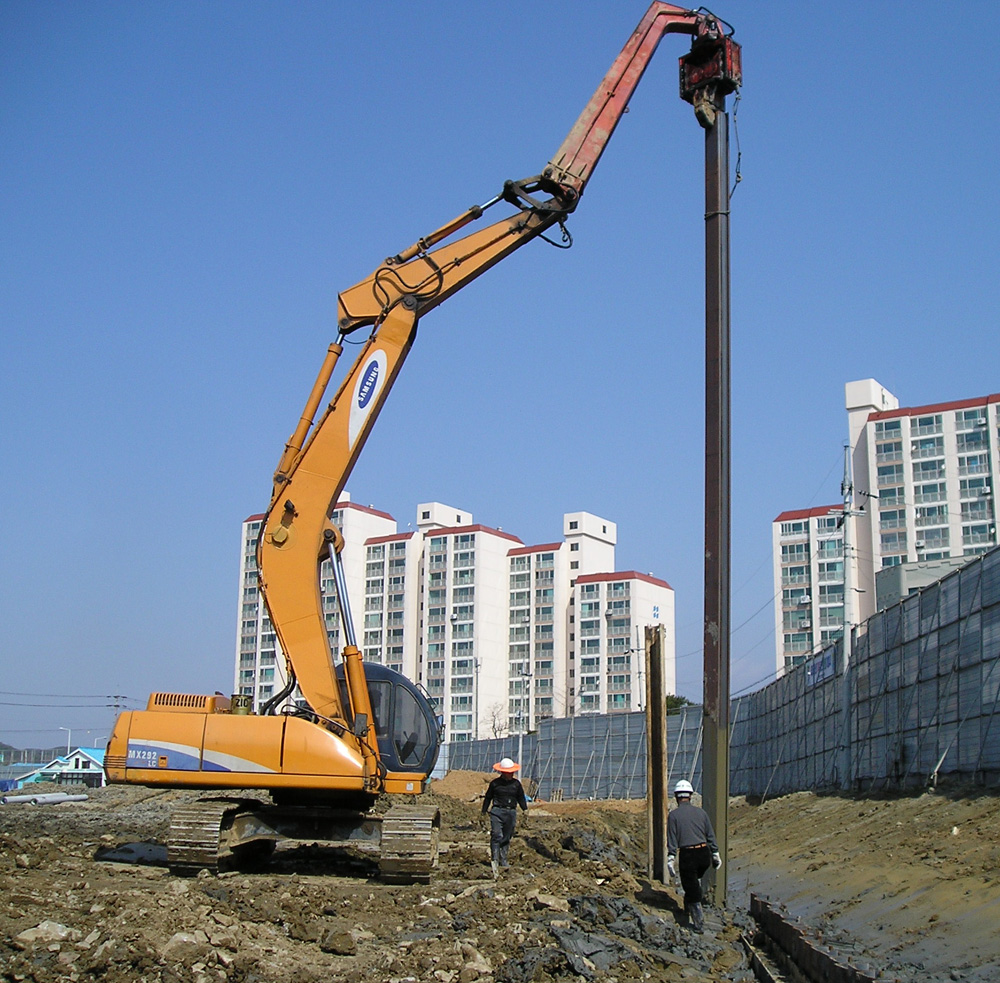Bored piles
Contents |
[edit] Introduction
Bored piles, also known as replacement piles, are a commonly-used form of building foundation that provide support for structures, transferring their load to layers of soil or rock that have sufficient bearing capacity and suitable settlement characteristics.
Bored piles are piles where the removal of spoil forms a hole for a reinforced concrete pile which is poured in situ. The spoil is replaced by the pile, hence 'replacement' piles as opposed to displacement piles where soil is forced away by driving or screwing the pile.
Bored piles are used primarily in cohesive subsoils for the formation of friction piles and when forming pile foundations close to existing buildings. They are popular in urban areas as there is minimal vibration, where headroom is limited, where there is no risk of heave, and if there is a need to vary the length of the piles.
[edit] Installation
Bored piles are drilled using buckets and/or augers driven by percussion boring (vibratory hammers) or through rotary boring (twisting in place).
In unstable soil strata, the use of bentonite fluid assists in stabilising the bore especially in large diameter deeper piles and allows the insertion of heavily reinforcing steel cages. This is known as flush boring (see more below).
If the boring and pouring takes place simultaneously, piles are known as continuous flight auger (CFA) piles.
Piles are known as large diameter piles if they are 600 mm or more in diameter. Small diameter piles of less than 600 mm are sometimes placed in groups under a common pile cap to receive heavy loads.
Large diameter piles can have their bearing capacity increased by under-reaming the shaft at the base. This is achieved by an expanding cutting tool which cuts a conical-shaped base up to three times the diameter of the main shaft.
The form of support to the pile or borehole affects the pile formation. Bored piles can be either supported or unsupported.
[edit] Unsupported piles
Where piling is undertaken in stable soils it may be possible to bore and place the concrete without first lining the hole. However, precautions need to be taken by lining the first metre of the hole to prevent surface spoil from falling into the hole.
[edit] Supported piles
There are two categories of supported pile depending on the casing or lining that is used.
[edit] Permanent casing
The borehole can be formed by the percussion method which involves a heavy cutting tool on a small tripod which is dropped from its raised position using a winch to cut out a cylinder of earth. The operation is repeated until the hole has been sunk to the required depth. As the cutting proceeds, a thin sectional lining is inserted into the hole to prevent its collapse. Alternatively, the borehole can be formed by the rotary method in which the rotary drill operates within the casing or lining.
[edit] Temporary casing
It is common for the borehole to be supported by a screw-jointed steel lining which is removed either during or after the concrete has been placed. The tube can be winched or jacked out of the ground.
Flush boring uses a fluid such as bentonite to flush material from the hole, which has been loosened by drilling. The fluid can be poured from above (reverse flushing) or pumped through the drilling rod (direct flushing). The bored hole is lined with a temporary steel casing to prevent collapse of loose surface soil. As the boring proceeds, bentonite is continuously fed into the hole.
At the required depth, reinforcement is lowered through the bentonite and concrete poured. The bentonite is displaced by the concrete and pumped back up out of the hole. As the concrete reaches the hole’s upper level, the temporary casing is withdrawn.
[edit] Related articles on Designing Buildings
- Continuous flight auger piles.
- Driven piles.
- End-bearing piles.
- Foundations.
- Friction piles.
- Geothermal pile foundations.
- Groundworks.
- Ground anchor.
- Micropiles.
- Moorfields building sets UK pile-loading record.
- Pad foundation.
- Pile cap.
- Pile foundations.
- Pile integrity test.
- Piling equipment.
- Screw piles.
- Secant pile wall.
- Sheet piles.
- Socket piles.
- Tension piles.
- Testing pile foundations.
- Types of pile foundation.
- Underpinning.
[edit] External resources
- ‘Introduction to Civil Engineering Construction’ (3rd ed.), HOLMES, R., College of Estate Management (1994)
- ‘Building Construction Handbook’ (6th ed.), CHUDLEY, R., .GREENO, R., Butterworth-Heinemann (2006)
Featured articles and news
Amendment to the GB Energy Bill welcomed by ECA
Move prevents nationally-owned energy company from investing in solar panels produced by modern slavery.
Gregor Harvie argues that AI is state-sanctioned theft of IP.
Heat pumps, vehicle chargers and heating appliances must be sold with smart functionality.
Experimental AI housing target help for councils
Experimental AI could help councils meet housing targets by digitising records.
New-style degrees set for reformed ARB accreditation
Following the ARB Tomorrow's Architects competency outcomes for Architects.
BSRIA Occupant Wellbeing survey BOW
Occupant satisfaction and wellbeing tool inc. physical environment, indoor facilities, functionality and accessibility.
Preserving, waterproofing and decorating buildings.
Many resources for visitors aswell as new features for members.
Using technology to empower communities
The Community data platform; capturing the DNA of a place and fostering participation, for better design.
Heat pump and wind turbine sound calculations for PDRs
MCS publish updated sound calculation standards for permitted development installations.
Homes England creates largest housing-led site in the North
Successful, 34 hectare land acquisition with the residential allocation now completed.
Scottish apprenticeship training proposals
General support although better accountability and transparency is sought.
The history of building regulations
A story of belated action in response to crisis.
Moisture, fire safety and emerging trends in living walls
How wet is your wall?
Current policy explained and newly published consultation by the UK and Welsh Governments.
British architecture 1919–39. Book review.
Conservation of listed prefabs in Moseley.
Energy industry calls for urgent reform.



























Comments